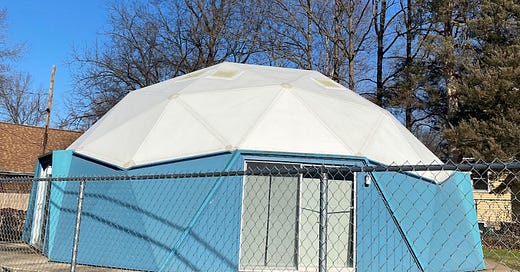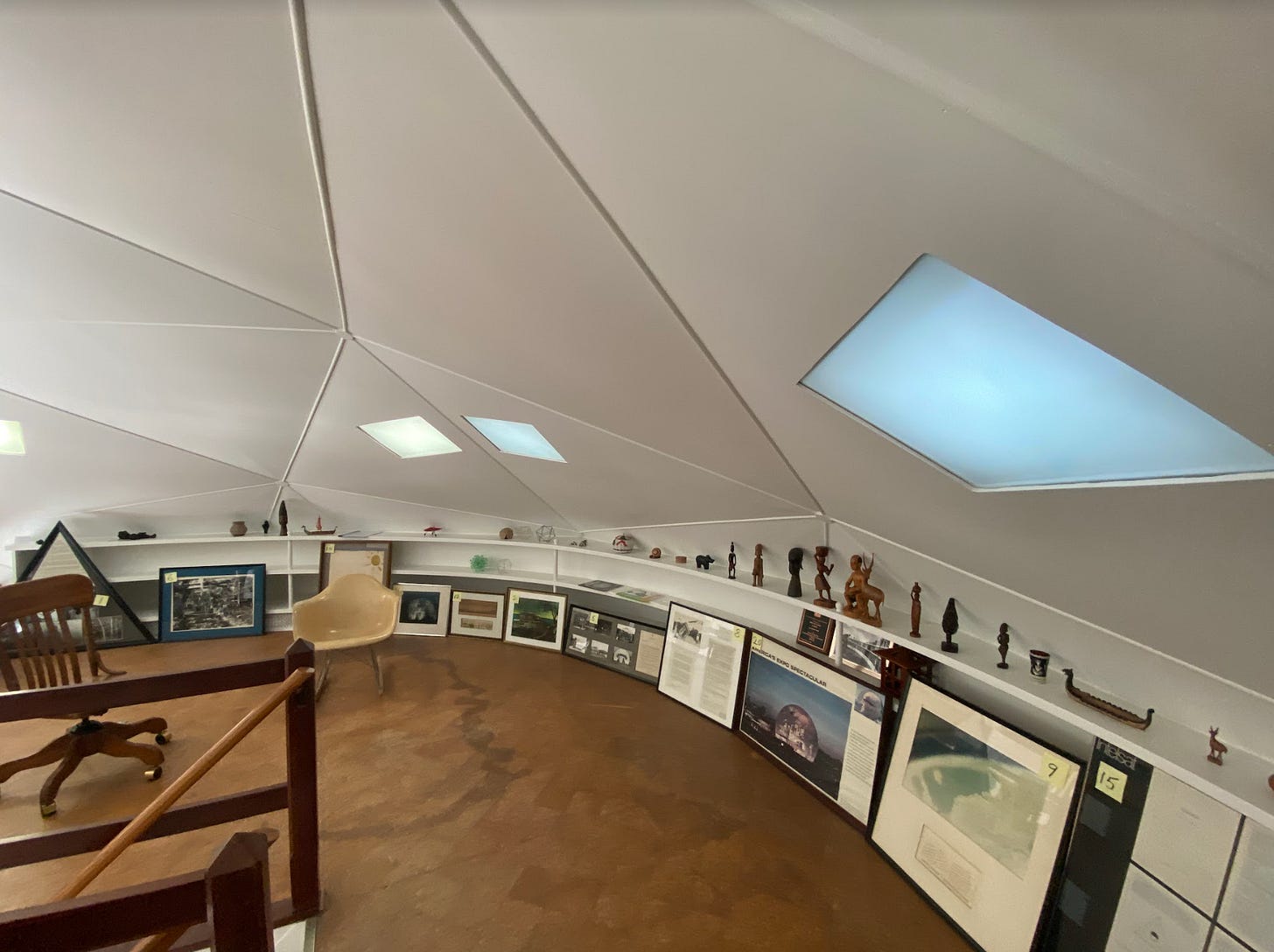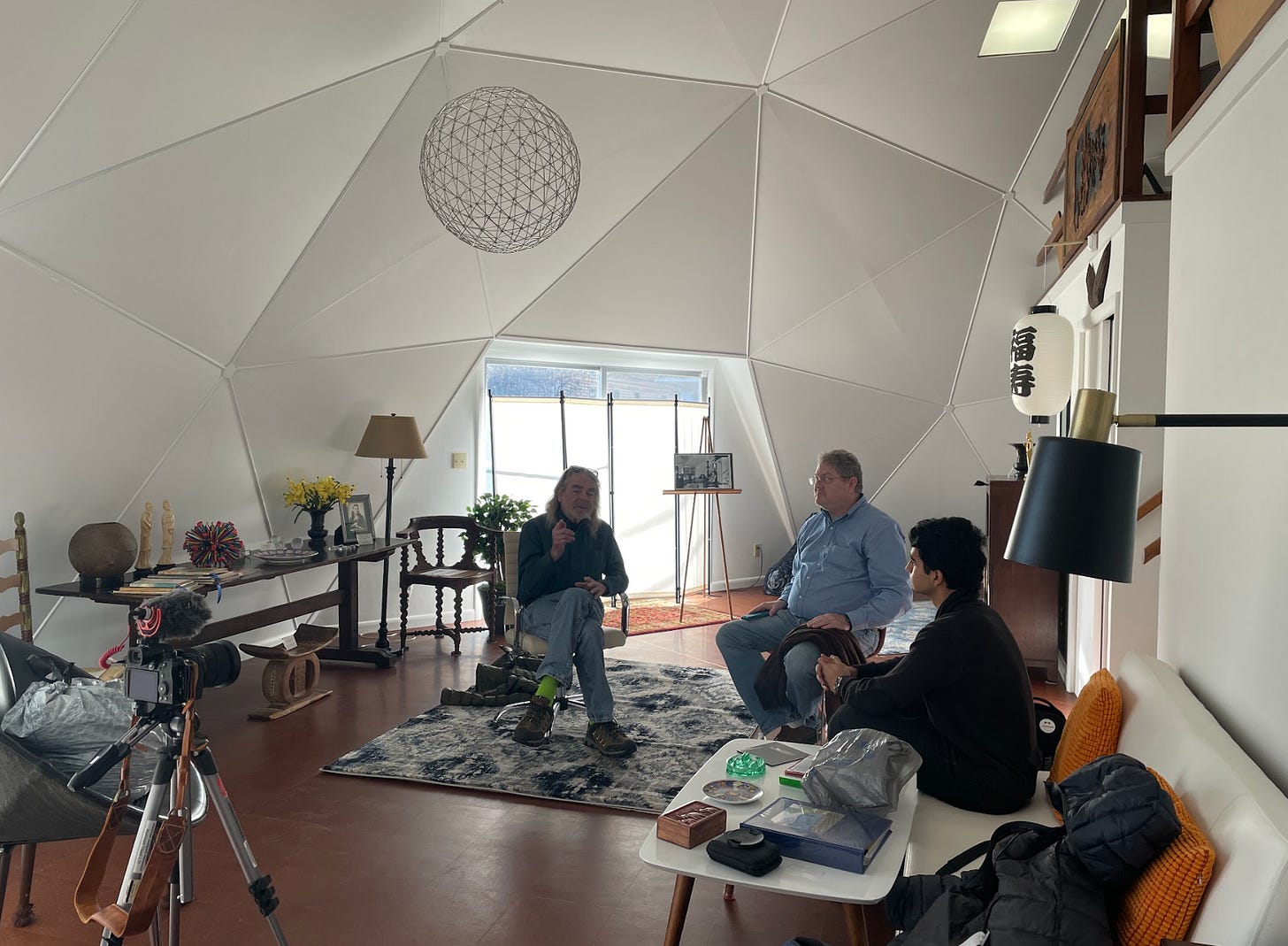Juan David’s Newsletter - January 29th, 2023
A Step into the Future: A Visit to the Fuller Dome House and the Unfolding Legacy of Buckminster Fuller
Morning,
One of my 2023 goals was to delve into the mind of Buckminster Fuller, a name that had piqued my curiosity for reasons I couldn't quite explain. But I've learned to trust my instincts and act on them, even if I don't know the outcome.
As I finished writing my Annual Review, I felt compelled to begin my exploration of Fuller, so I opened up his Wikipedia page and started delving into the depths of his work. Whenever I encountered something I didn't understand or wanted to know more about, I dove deeper by reading the sources cited on the page.
On one of the first days, I spent more than two hours1 entranced by the Dymaxion Car, marveling at its mechanics, physics, and inspiration. I couldn't help but wonder why this vehicle wasn't more prevalent in today's society.


What’s my process? I write to teach myself. I ask myself questions and find a way to answer them. I've found that writing is an effective way to teach myself. I ask myself questions and strive to find answers, making the learning process a joyous experience. One day, I'll delve deeper into this process in a separate piece.
As I delved deeper into Buckminster Fuller's work, I couldn't help but ponder the question of why his ideas never gained widespread acceptance.
And then it hit me: Elon Musk is someone who has been successful in bringing his ideas to fruition. So, I decided to compare and contrast the approaches of these two individuals in a Twitter thread.



You can’t compare Musk and Fuller, but back then, my understanding of Fuller was limited.
So, I wrote and shared2 the thread on various online platforms, including a Buckminster Fuller subreddit.
One of the beautiful things about the internet is that if you want to know the answer to something, post the wrong answer, and people will correct you (and help you) find the right answer.
So that’s exactly what I did.
Someone replied, telling me that my framing was flawed and that I didn’t understand Fuller’s vision. “Perfect. Please tell me more.” I said inside of myself.
This initial conversation had a domino effect. We started DMing each other on Reddit and my understanding of Fuller's ideas rapidly expanded. I learned not just facts but also the right context and framing in which to understand them.
Framing matters because a bad question will give you a bad answer.
Here’s where it gets interesting.
As it turns out, the person I was conversing with on Reddit wasn't just a random person. Cornelius Crane is one of the most knowledgeable individuals on Buckminster Fuller and even served as the first president of the nonprofit organization that preserved Fuller's Dome House.
Cornelius invited us to visit the Dome House and have a conversation, and last weekend, that's exactly what we did. The UIUC Talkshow team traveled to Carbondale, Illinois to see the Dome House for ourselves.
Buckminster Fuller was once a professor at Southern Illinois University, and instead of living in a traditional rectilinear house, he built a geodesic dome.

Let’s take a look at the inside.
A video showcases the beauty of the dome a bit better but still not enough.
But no matter how many pictures or videos I show you, I could never truly convey the feeling of being inside that house. It's a feeling of boundless creativity, where all ideas seem possible and flow naturally. It's a feeling of safety, where the only thing on your mind is thinking about important ideas.
The Dome House itself was a true work of art. The unique shape and design of the dome allowed for an abundance of natural light to flood the interior, creating a warm and inviting atmosphere. The curved walls and ceiling made me feel as though I was inside of a giant seashell, enveloped in a cocoon of creativity.
We toured the house, took pictures, and then sat down to have a conversation with Cornelius Crane and Jon Davey, an Architecture Professor at SIU and current president of RBF Dome.

As we meandered through the house, Cornelius and Jon regaled us with stories and anecdotes about Fuller and his work. They spoke of his passion for innovation and his relentless drive to push the boundaries of what was possible. They also spoke of his commitment to sustainability and his belief that humanity had a responsibility to care for the earth and its inhabitants. As we delved deeper into the conversation, they shared insights about the individuals3 in the Carbondale community who have helped preserve Fuller's legacy.
Not only were we treated to this extraordinary experience, but we were also left with a wealth of knowledge, armed with a plethora of books by Buckminster Fuller, Norbert Wiener, and Stafford Beer. I couldn't wait to delve into these volumes and uncover new ideas and potential projects!
I embarked on this journey with a question: "Why don't I see Fuller's ideas today?"
After our visit to Carbondale, I gained a clearer understanding of Fuller's vision and what he was striving to achieve.
What did I learn about Fuller that I didn't know before?
Fuller was attempting to showcase a 4th-dimensional universe, and his inventions, such as the Dymaxion Car, the Dymaxion House, and the iconic geodesic domes, were simply demonstrations of this concept.
His goal wasn't to mass-produce these inventions. Perhaps he could have, but the path to producing and selling these often went against his personal mission statement:
To make the world work for 100% of humanity in the shortest time possible through spontaneous cooperation without ecological damage or disadvantage to anyone.
—Buckminster Fuller
He did not want to disadvantage anyone, such as factory workers.
Fuller wasn’t interested in worldly recognition but rather in discovering the fundamental structure of the universe.
Buckminster Fuller proposed that there are three building blocks of the Universe: the tetrahedron, octahedron and icosahedron are the most important building blocks of nature.
Fuller was the first to describe the tetrahedron as the simplest structural system with insideness and outsideness, and it was his most important building block, the form on which the rest of synergetic geometry hinged.
So many exciting ideas will take me time to digest fully.
As we drove back to Champaign-Urbana, I knew that I had been given a gift. The opportunity to visit the Dome House and hear firsthand accounts of Fuller's work had given me a deeper understanding and appreciation of his ideas. We had just received more context on which to explore his work and apply his principles in future projects as well as my own life.
Buckminster Fuller is the beginning of a journey into the forgotten world of cybernetics, and I can only keep reading, learning, and asking questions.
Where will they lead me? I have no idea. I trust everything will come around and make perfect sense.
You can't connect the dots looking forward; you can only connect them looking backwards.
So you have to trust that the dots will somehow connect in your future. You have to trust in something - your gut, destiny, life, karma, whatever.
This approach has never let me down, and it has made all the difference in my life.
—Steve Jobs
I choose to trust. I choose to listen to my intuition. I choose to follow my obsessions.
Have a great Sunday,
Juan David Campolargo
Read past issues.

How did I spend two hours? How do I have so much time? On this day, I woke up at 5 AM so by the time I finished, it was 7 AM.
It’s not enough to do the work, you must also distribute it.
One of these people was Bill Perk who bought the dome and started the RBF Dome foundation.











Cool experience. Always impressed by the serendipity of your public explorations!
Awesome!! The ideas too, but also your writing voice and one day soon do share your process it sounds very fun + learning so.. we gotta know!